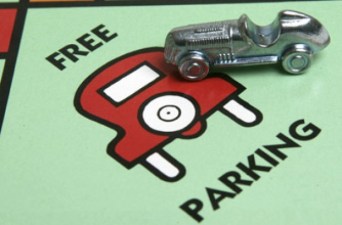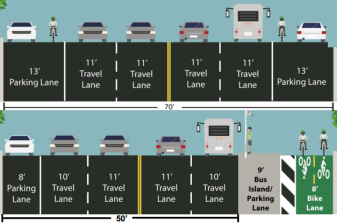The Case Against Pull-in Angle Parking

"Pull-in angle parking" on 97th Street between Central Park West and Columbus Avenue.
The drive to create additional (free) parking for the benefit of New York City’s auto-owning minority takes many shapes and forms. Today, I’d like to take aim at a particular form of curbside parking: "pull-in angle parking." I’ve seen this type of parking in a few areas of the city, but I’ll contain my assessment to the street I live on — W. 97th Street between Central Park West and Columbus.
Rather than the typical, curbside parallel parking, on my street cars park bumper-to-curb at a 45 degree angle to the sidewalk. On my extra-wide street, this has increased the total supply of parking spots by 30 to 40 percent.
In some sense, it seems to be a decent trade-off — less space for through-traffic and more space for local residents and visitors to store their motor vehicles. West 97th Street could be a dangerous four-lane speedway if all of the available road space were used to move traffic. The angle parking is a way of putting this block on a road-diet, though, installing bike lanes, a dedicated bus lane, a planted median or wider sidewalks would have the same result.
From a cyclist’s perspective, this stretch of 97th Street feels really dangerous because drivers have little visibility of the road as they back their vehicles out of their parking spaces. Twice biking down my street I have had to swerve out into traffic to avoid a motorist blindly backing out of his parking space. A couple of weeks ago, I had the experience of parking a friend’s car in one of these spots and I couldn’t comfortably pull-out without someone helping to let me know when the coast was clear.
After checking out CrashStat 2.0, the middle of this block does not have any more pedestrian or cyclist injuries than the average middle block. But CrashStat doesn’t look at auto vs. auto crashes, which seems to be the more likely danger at this location because of the lack of visibility.
If angle parking is what we we really, truly want on this block (rather than bike lanes, bus lanes, wider sidewalks or a greener streetscape), there’s a safer, better way to design this kind of parking. It’s called "back-in / head-out angle parking." You can download a Nelson Nygaard report on it right here.

From the report, we find that:
This type of parking provides a safer environment for bicyclists using the roadways. The
driver is able to see the cyclist easily when exiting the stall. Several cities where back-in
angle parking has been implemented have seen a reduction in number of accidents
compared to the number of accidents at regular parallel parking schemes. Matt Zoll at
Tucson-Pima County Bicycle Advisory Committee says that after implementing the back-in/head-out angle parking scheme in Tucson they "went from an average of 3-4 bike/car accidents per month to no reported accidents for 4 years following implementation."
And furthermore, they cite the Salt Lake City Q&A about Back-in parking
As SLCTrans (2004) states, "one of the most common causes of accidents is people backing out of standard angled parking without being able to see on-coming traffic. Reverse angled parking removes this difficulty." It also improves safety for cyclists, and for loading/and unloading the trunk of the car. Similarly, the Urban Transportation Monitor’s recent article on back-in angle parking reported reduced accidents and benefits for bicyclists in several communities. In all, back-in/head-out angle parking is a good choice when compared to conventional head-in angle/back-out parking and parallel parking.
Head-out angle parking is clearly the safer choice. For West 97th between Central Park West and Columbus Avenue, I hope that the next road repaving will include a redesign. And while we’re at it, a bike lane on 97th street from Central Park West to Riverside would be grand too!

